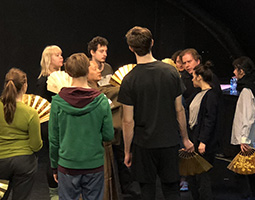INDEX

Taneda Michikazu 
Scene from a performance on a noh stage in Japan 
Participants in the Budapest, Hungary workshop study the various uses of fans in noh 
Taneda dresses a participant in the costume for the noh play Hagoromo (The Feather Mantle)
- PREVIOUS
- NEXT
December 2021
A Noh Actor Discovers that “Art Knows No Borders”

Taneda Michikazu, noh master of the Kongo School, served as a Japan Cultural Envoy in 2018, teaching noh at workshops in the United States, France, Spain, Italy and Hungary. Taneda tells us about his experiences.

Noh, one of Japan’s great traditional performing arts, is a type of musical theater in which the actors perform while wearing masks and beautiful costumes. The actors speak lines and dance or use gestures to bring the narrative forward, doing so to the sounds of Japanese traditional instruments and chanting called utai.
Of the five schools* of noh in Japan, the Kongo School is the only school to be based in Kyoto. Taneda Michikazu comes from a lineage that has supported this school over generations.

According to Taneda, “Noh has been passed down without interruption for about 650 years and is considered the world’s oldest extant performing art. Noh’s longevity is likely because it was protected by the rulers of every age; however, it is not the case that noh actors have clung to the powerful or pandered to their tastes. Put very simply, noh may have provided people with a kind of ‘healing.’ The expression of multi-faceted human relationships in noh, such as parent-child and teacher-student relationships, still has relevance for modern society. This must be because noh explores people’s true nature. I believe that is why “nohgaku” (noh theater) was the first art form in Japanese culture to be inscribed on UNESCO’s Representative List of Intangible Cultural Heritage of Humanity**.”

In 2018, Taneda visited the United States, France, Spain, Italy and Hungary in his capacity as a Japan Cultural Envoy. Normally, noh is performed by twenty or so people, each playing a specific role (see photo below), but as a Japan Cultural Envoy Taneda was the only actor who could perform, so putting on a noh play as usual was impossible. “Therefore,” says Taneda, “for those shows, I decided to show everyone a performance where I use my body as much as possible, performing parts of plays that only involve one actor. I also decided that participants should not just watch these performances but also experience noh using their own bodies. To achieve this, with the help of staff from the Japanese Government’s Ministry of Foreign Affairs and the Japan Foundation, I made pronunciation cards for each language so that the participants could recite the Japanese lyrics as closely as possible and do the utai chant while I performed a dance in accompaniment.”
Additionally, Taneda took along twenty-five folding fans from his collection. In noh, the fan is a tool for expressing mental images, scenery, and also objects. As part of his workshops, Taneda had the participants hold the various fans and gave instruction in their use and movements so that participants could feel the different meanings through the experience of using their own bodies.

Taneda recalls a moment that left an especially strong impression on him after giving a workshop in Barcelona, Spain. “We had just finished a workshop for drama students, and one person said, ‘Noh is silencio’ (meaning “silence” in Spanish). I hadn’t specifically taught quiet movements, but I think that person had nevertheless grasped the essence of noh.”
In Kakyo (A Mirror of the Flower), a treatise on acting by the noh master Zeami, who brought noh to perfection in the second half of the 14th century, the concept of yugen (profound grace and subtlety) is considered of utmost importance. For example, even if you are playing an oni (demon or fiend), you should dance quietly and beautifully.

Taneda says, “The root of silencio is the same as for yugen. I was moved by the high spirituality of that person who perceived this after just a one-week workshop.”
Even for a Japanese person, it is difficult to truly understand the essence of noh, but Taneda felt that traveling the world as a Japan Cultural Envoy allowed him to experience the depth of feeling foreign people have towards Japanese traditional art. He says that he came to understand firsthand that “art knows no borders” and deepened his sense of noh’s potential.
* There are five schools of shite (main role) actors.
** Nohgaku was inscribed on UNESCO’s Representative List of Intangible Cultural Heritage of Humanity with Ningyo Johruri Bunraku and Kabuki in 2008.
- PREVIOUS
- NEXT

